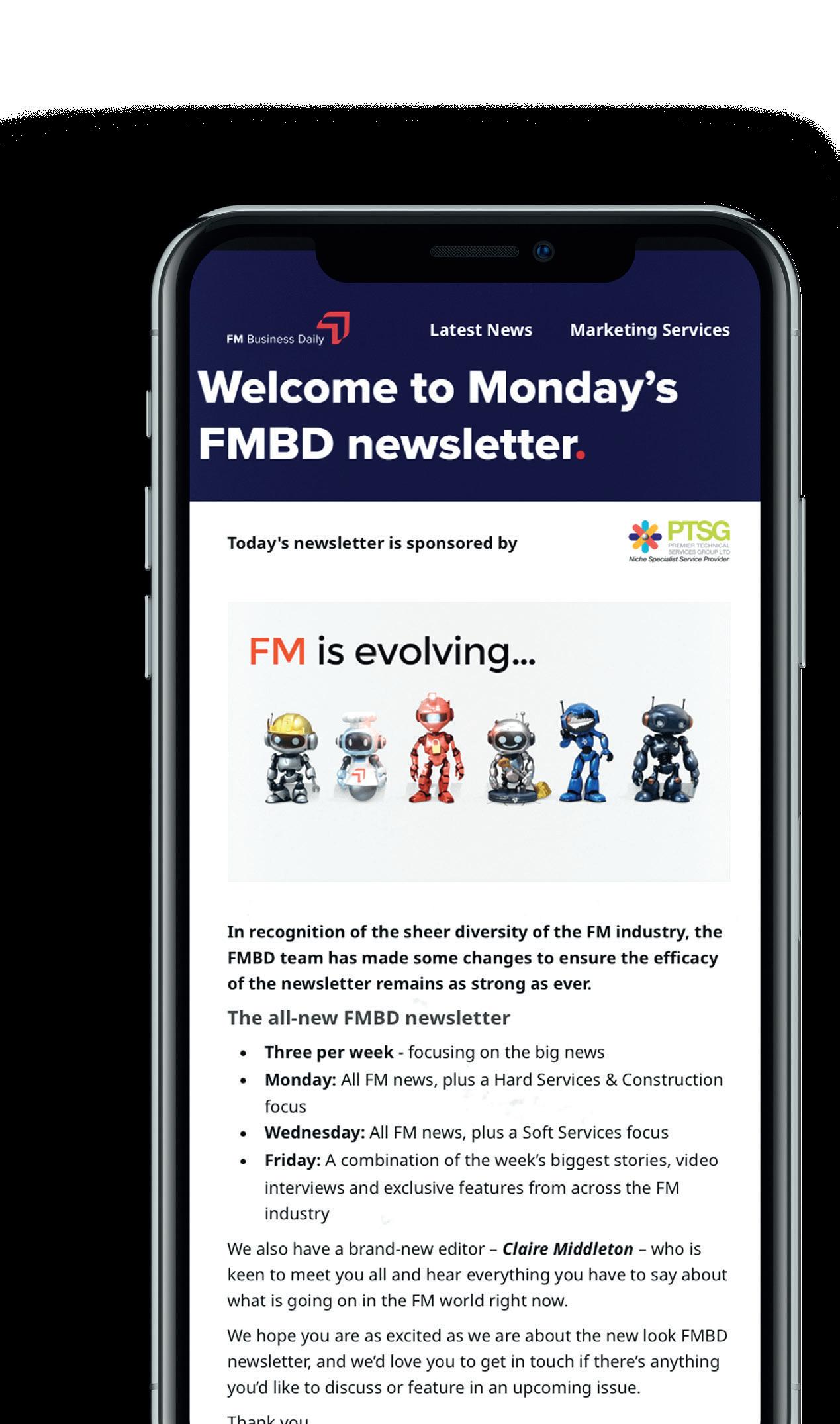














Sponsored by








Welcome to our first special edition of the year – Innovation in FM. In this exclusive issue we look at just a handful of the forward-thinking businesses who are driving innovation across our industry.
James Massey, MRI Software’s Managing Director of Facilities, Energy and Retail Intelligence, talks about harnessing the power of tech for good.
Kathryn Vassilissin, Sales Manager, Vendor Finance, Siemens Financial Services UK discusses the importance of financing high-functioning workspaces for a hybrid workforce.
All this and much more in the pages ahead – enjoy!
Claire Middleton
claire.middleton@businessdailygroup.co.uk

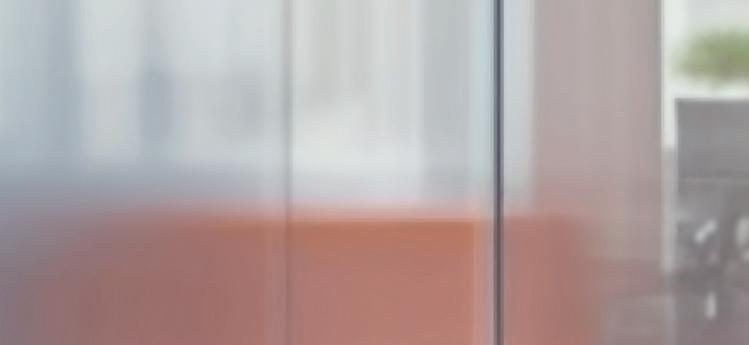
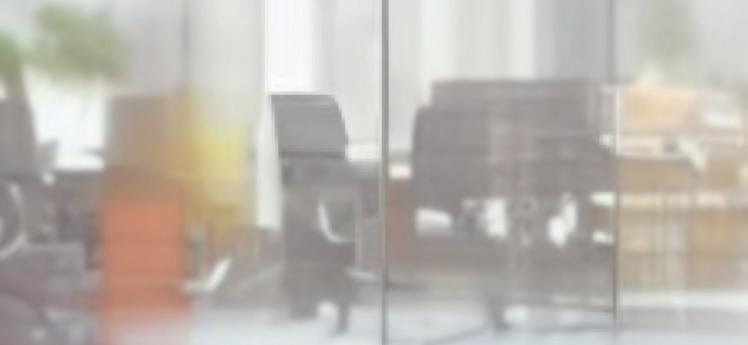













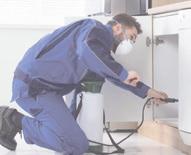









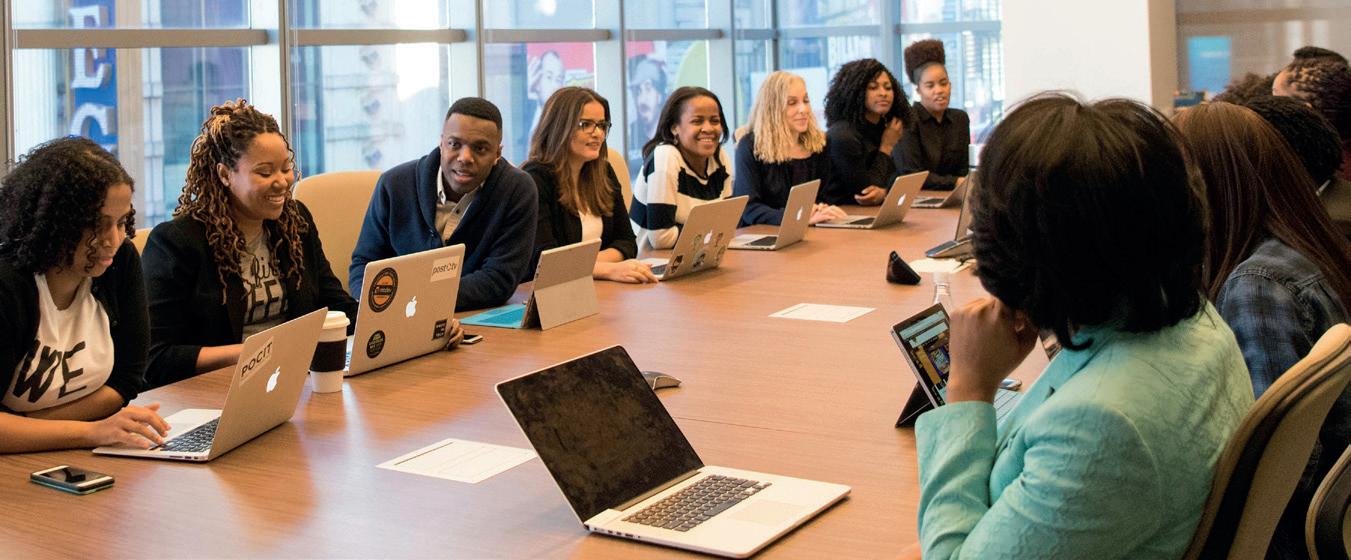





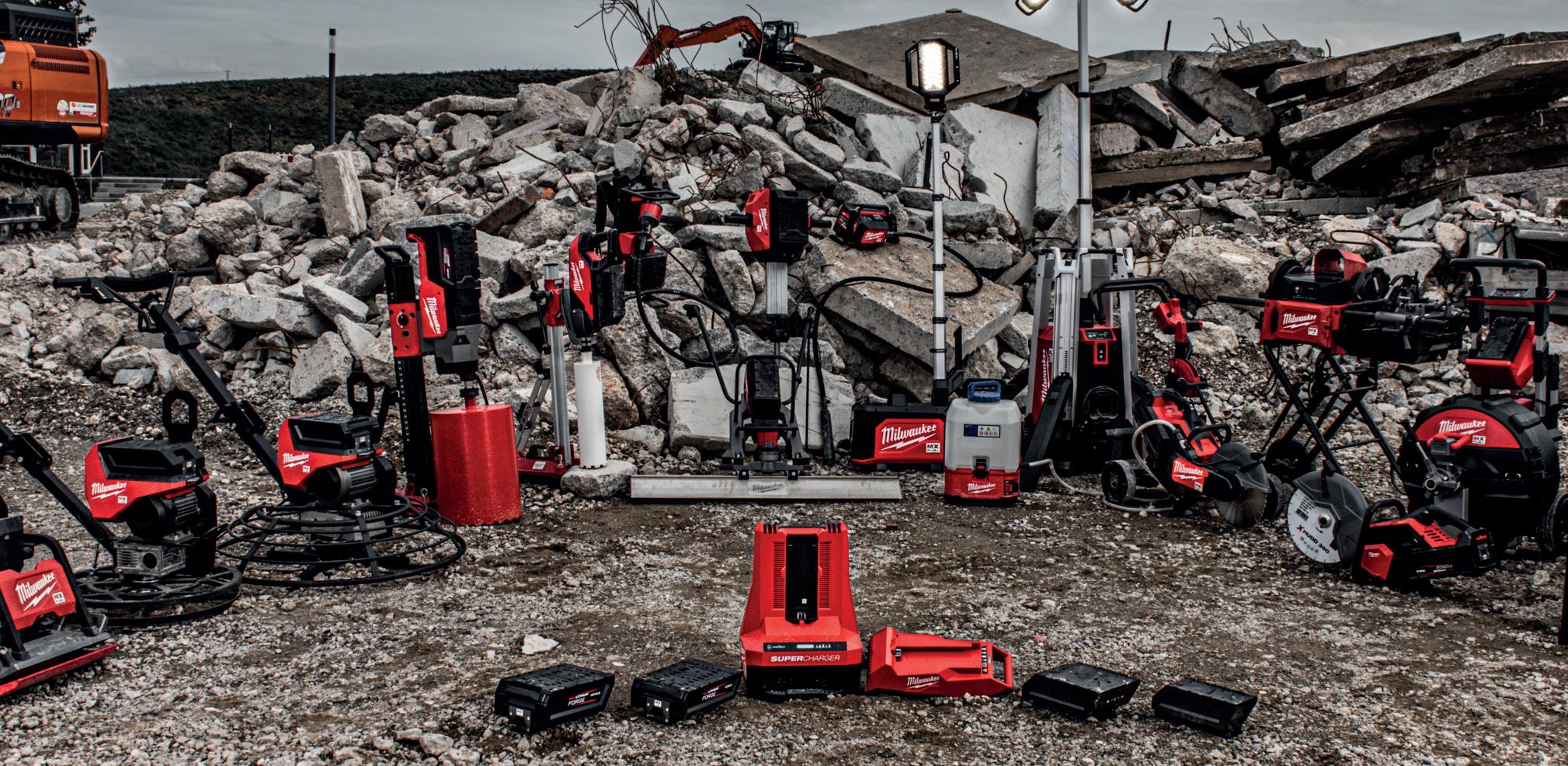
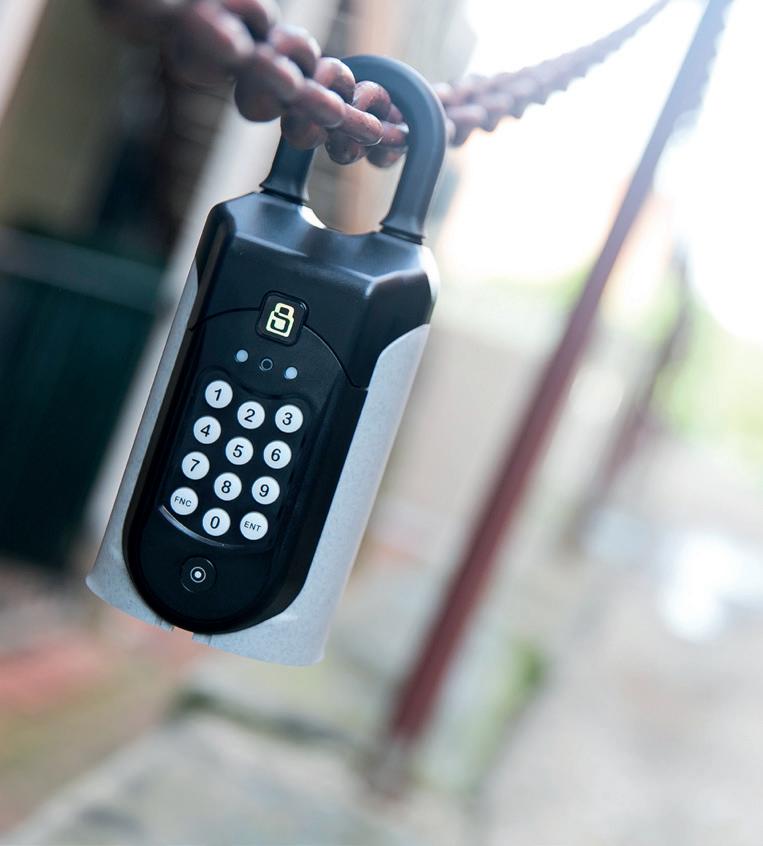
The barriers that once prevented FM businesses from harnessing their data effectively are falling. Gone are the days of relying on outdated reports, gut instinct, or unwieldy spreadsheets, writes David Leslie, Head of Strategy & Client Success at Datore


Analytics as a Service is democratising access to advanced data capabilities and game-changing insights, all without the huge upfront costs, technological complexities, and recruitment headaches historically associated with building and executing a data strategy.
How Analytics as a Service is Powering FM Innovation
Businesses that have been quick to adopt Analytics as a Service are all thriving for the same reason; data has become their differentiator in a space where differentiation is notoriously tough but increasingly critical.
Datore’s AaaS is essentially a fully outsourced data department. Think: on-demand data team, all the necessary software, and a bullet proof plan to turn your messy data into impactful insights – all for a single, affordable subscription.
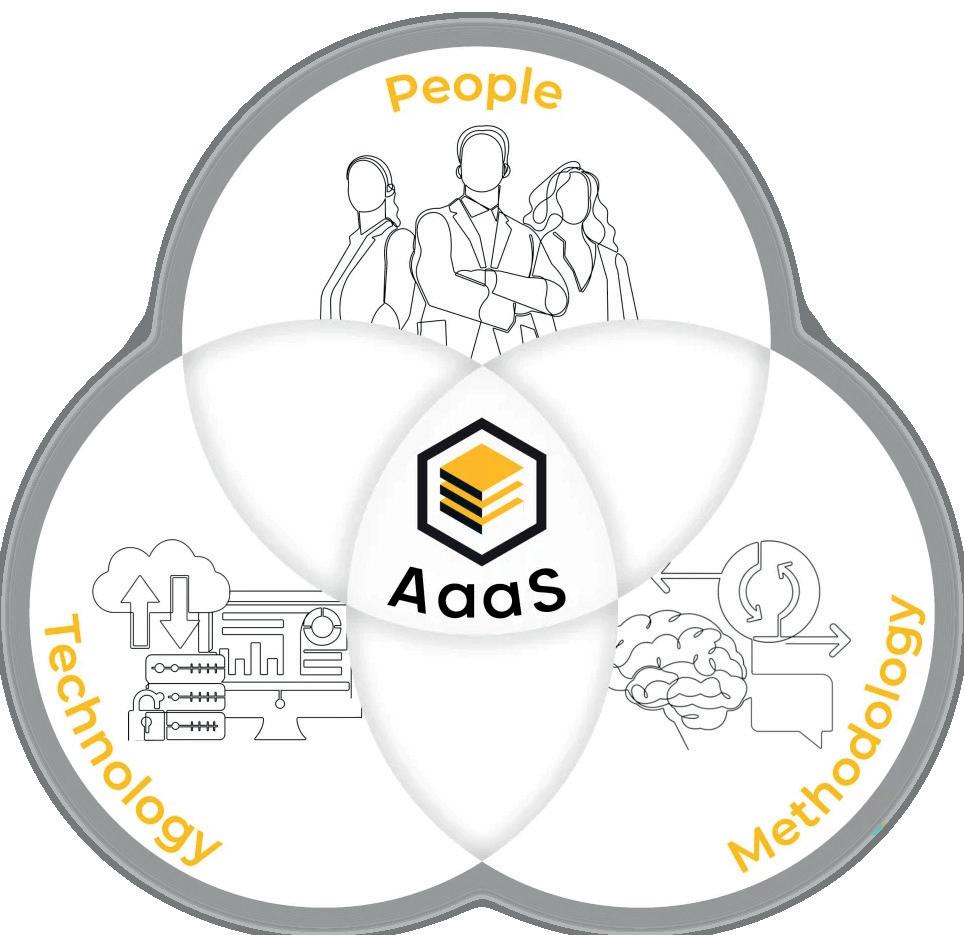

52% of FM professionals state – “data & analytics is the real game-changer reshaping FM over the next few years”
So, how exactly does Analytics as a Service power the FM innovation?
1. Innovative ways to increase margins (turning good accounts into great accounts).
Strategic resource allocation, better planning, optimised service delivery, uncovering hidden costs... With Analytics as a Service FM providers benefit from predictive insights to anticipate maintenance needs, reducing downtime and repair costs. Data-driven scheduling ensures that teams are deployed effectively, improving response times and reducing unnecessary site visits. The result? Higher margins, saved time, and stronger relationships with clients.
2. Proactively transforming client relationships
Analytics as a Service helps FM service providers satisfy the increasing demand for a client analytics portal. The reality is: those who don’t have those capabilities are losing bids they should easily win.
Luckily, client analytics portals are not out of reach for FM businesses without massive data departments.
With AaaS organisations are deploying portals quickly, transforming failing relationships into thriving partnerships through radical transparency of services.
3. A fresh approach to top talent retention
Q. How do you tackle the skills shortage in FM? A. keep your best people! Businesses armed with insights about their workforce, effortlessly retain their top talent by the early identification of flight risks, saving a fortune on recruitment whilst maintaining the highest service levels.
AaaS also empowers employers to proactively seek out knowledge gaps and upskill client teams accordingly ��
AaaS-Driven FM – From Cost Centres to Strategic Partner
For FM providers - traditionally viewed as cost centres - Analytics as a Service represents an opportunity to reposition as strategic partners.

The conversation is shifting from price to value because they can quantify the impact of their services on client operations—from energy savings to space optimisation and asset longevity.
What makes AaaS particularly potent here is its scalability and rapid deployment. Unlike the traditional approach that can take years to deliver value, Analytics as a Service can be operational within weeks. The solution grows alongside the business, handling increasing data volumes without requiring significant further investment.
As 52% of FM professionals state – “data & analytics is the real game-changer reshaping FM over the next few years”. Analytics as a Service is reducing the timelines of that ‘reshaping’ from years to months. Those who embrace analytics and insights will lead the industry forward, and those embracing AaaS will do it first – datadriven FM is now.
David Leslie has15 years experience in technology and 10 in data & analytics. David currently heads up Strategy and Client Success for Datore; the UK’s only AaaS provider focused on the FM space.












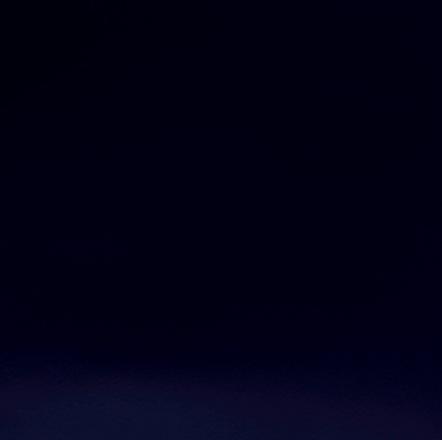































Even routine tasks can become harder to manage when visibility is low and admin is high. That was the challenge facing cleaning teams and managers across a large retail estate, with paper-based systems and limited audit trails making it difficult to monitor trends, evidence service delivery, or act on issues in real time



At Arcus FM, that meant asking a simple question: how can we improve cleaning performance while reducing the admin burden and delivering greater confidence to our customers?
That question led to the creation of Arcus Connect — a bespoke operational platform designed to track task completion, monitor performance, and create a robust, real-time audit trail for essential day-to-day activities.
Built with collaboration from store teams and operational leads, the solution brings greater clarity to cleaning delivery, supporting compliance, efficiency, and continuous improvement.
Understanding the challenge
Essential cleaning tasks like spill response and scheduled checks are constant in busy retail spaces. But without a consistent way to log activity, it’s hard to spot patterns, measure performance, or provide clear evidence that specifications are being met.
Relying on paper-based systems meant task records weren’t always accessible or easy to audit, especially across multiple sites. Managers had limited visibility of what was happening on the ground, and store colleagues were spending valuable time on admin that didn’t directly support service delivery.

The goal was to reduce manual processes, improve transparency, and build a reliable audit trail, all while keeping things simple for those delivering the work.
Designing a smarter system
Arcus Connect was developed in collaboration with our customers. From the outset, the aim was to build something tailored, practical, and scalable — a tool shaped by those who would use it.
Together, we began trialling the platform at a pilot site. Cleaning specifications were broken down and mapped to key zones across the store. Each area was then assigned an NFC tag, connected to specific tasks and frequencies. These tags now act as a digital checkpoint, confirming the who, when, and what of every task carried out on site.
The system allows Arcus teams to scan tasks as they go, creating a live picture of activity at both site and estate level. From spills to routine cleans, each completed action builds a transparent record that can be accessed instantly by managers and the customer’s team.
What it’s delivering Arcus Connect is already changing how we manage and monitor cleaning performance.
The goal was to reduce manual processes, improve transparency, and build a reliable audit trail, all while keeping things simple for those delivering the work
By breaking down the specification and assigning tasks to NFC tags, the platform creates a clear activity plan for colleagues and total visibility for managers.
Spill reports now include timestamps, photos, and central logging, making it easier to respond to incidents and support audit and compliance needs.
Daily reporting on washroom issues helps track outstanding tasks and improves accountability.
By digitising task tracking and making performance data easy to access, the platform empowers teams at every level — from in-store colleagues to account managers — to take a more proactive, informed approach.
Live dashboards show real-time progress across all stores, enabling quicker decisions and more targeted support. With less need for reactive oversight and unnecessary travel, teams can focus on delivering where it matters most.
Designed for what’s next
Arcus Connect was built to evolve. As more features are added — from live audit tools to integrated reporting — the platform will continue to adapt to customer needs and operational realities. We’ve already introduced UK-wide visibility, allowing managers to view live progress across all sites and receive alerts when tasks are overdue.
What began as a solution to reduce admin has become a powerful tool for performance management and estate excellence.
As we continue to scale, Arcus Connect will play a key role in shaping the future of soft services at Arcus.
Find out more at arcusfm.com
Live dashboards show real-time progress across all stores, enabling quicker decisions and more targeted support



















By Kathryn Vassilissin, Sales Manager, Vendor Finance, Siemens Financial Services UK

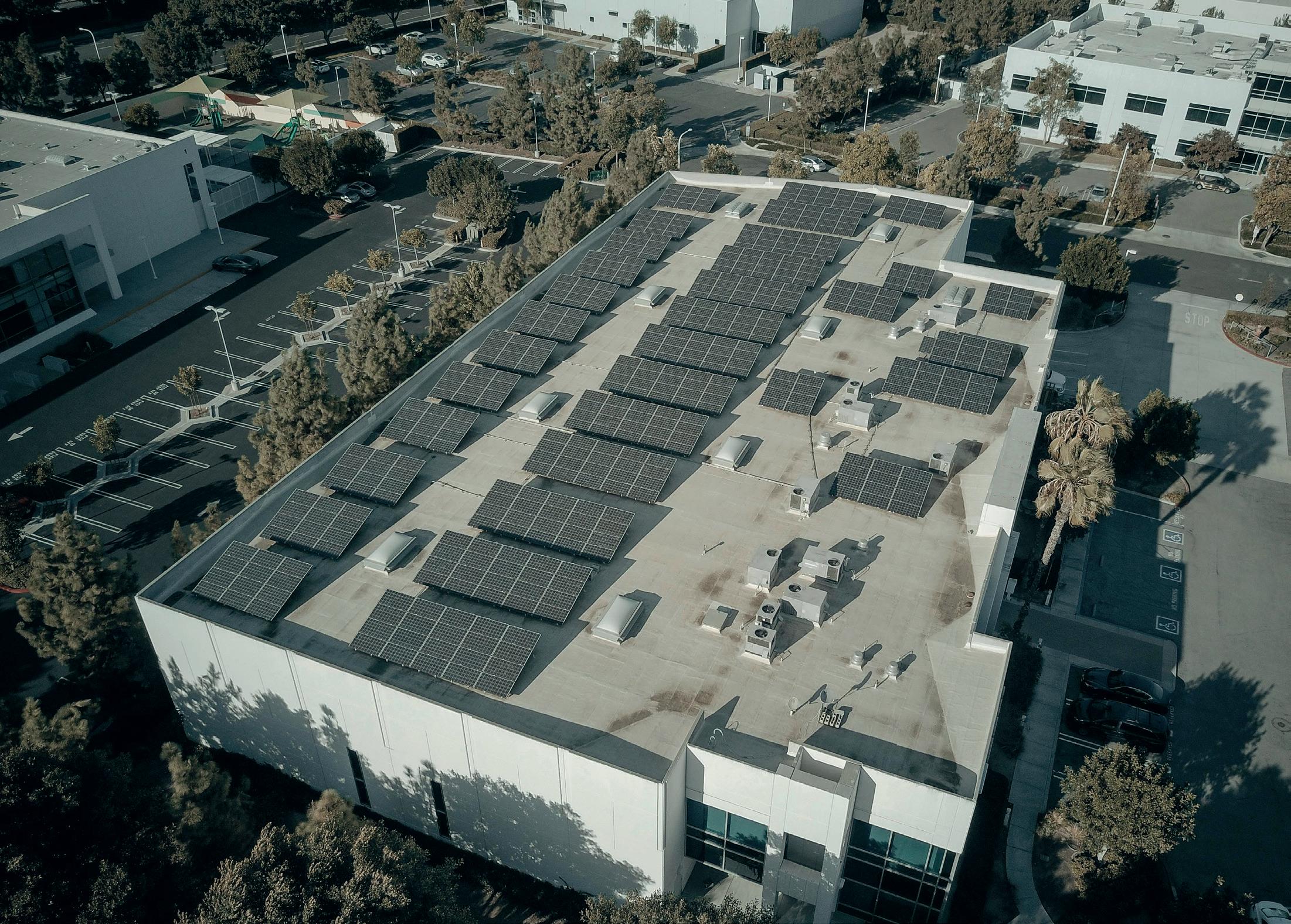
“If occupancy at a workplace has dropped 50%, shouldn’t FM costs fall by a similar amount?” Many in the industry will be asking the same question as this commentator, writing on the evolution of facilities management in the workplace.
Though some businesses are upping their office days, 60% of employees said they had flexible working arrangements in 2023, a jump from 51% in the previous year. This change in working habits has forced a revaluation of the responsibilities of a facilities management (FM) company.
Operating a hybrid working environment means providing highfunctioning, flexible office premises, that make greater use of technology to adapt to usage. This is necessary to be able to react to current market trends and remain competitive.
Hybrid working – here to stay?
Some remain unconvinced by the longevity of hybrid working or may be hesitant to commit to a costly restructuring of facilities, but it would be a mistake to dismiss it as a fleeting trend.
One study has found that over three-quarters of employees would actively look for a new job, or be willing to consider one, if their company’s flexible work policies were to be reversed. It is not just staff who feel this way. Businesses know that offering flexible working attracts talent and helps to address skill or labour shortages.
Adapting to hybrid working is therefore an imperative, but what does this mean in practice? It could entail upgrading equipment, connectivity and security systems or changing the structure of how a workplace operates.
For example, it may be more efficient to introduce self-service catering, such as a vending mini market, rather than having a manned catering service that is unused or underused at certain times of the week. Office usage could be better anticipated and managed by introducing smart technology that registers when people come onsite, how they use the premises, and at what times. However, implementing these new measures comes with a cost and this may be a prohibiting factor –especially in today’s uncertain economic conditions.
Businesses know that offering flexible working attracts talent and helps to address skill or labour shortages

The cost of upgrading facilities to meet hybrid working demands is therefore a struggle for many facilities management companies
The immediate cost of doing business has gone up due to rising inflationary pressures. The cumulative total of operational costs and staff costs, as well as the cost of maintaining and replacing assets and equipment, represents a significant financial challenge for businesses in a period where their money is worth less.
Hybrid working can introduce new cost and complexity, where employers are providing screens or other necessary equipment both in the office and for the home, as well as ensuring sufficient cybersecurity and connectivity speeds at both locations.
Subsequently, companies are finding themselves less agile and less willing to use their own capital to invest in depreciating equipment.
The cost of upgrading facilities to meet hybrid working demands is therefore a struggle for many facilities management companies, despite the commercial and competitive advantages to be gained from doing so. This is where finance from specialist financiers can help to make investment affordable.
When businesses are hesitant to tie up cash in depreciating equipment and technology, leasing arrangements can present a powerful financial solution.
Payments are structured across an agreed period and aligned to match a business’ cash flow. Spreading the cost of investment means that the FM provider avoids a heavy upfront cost and instead retains free capital for liquidity or use in other parts of the business, e.g. strengthening the salesforce.
Financing can take a variety of forms, from basic leasing and hire purchase agreements to master leases with an agreed line of credit. This is useful for FM companies that want to acquire large equipment volumes quickly, as required, without having to go through laborious financing applications for each asset.
A further option is a managed service agreement. This solution guarantees the uptime and capability of an agreed service level at a fixed monthly cost.
This can embrace sub-components such as fire protection, security, ventilation or energy efficiency. Under such an agreement, the costs of the equipment, delivery, installation, maintenance, insurance etc., are all incorporated into the contract.
With a multitude of financing options available, the question facing FM providers becomes less about how to invest, but rather, how much can be consolidated with financing from a single source?
It can be a time-consuming and meticulous process to administer many small agreements for separate items, and it is not as straightforward to negotiate a favourable deal compared to negotiating for a whole package.
Specialist financing partners (like Siemens Financial Services), for instance, have a deep knowledge and understanding of workplace technology and equipment, which means they can fund the wide range of assets required in an office environment under one single package.
Such an arrangement could cover, for example, door entry systems, 24-hour CCTV, vending machines, IT hardware/software, photocopiers or smartphones.
Certain industries will require more specific equipment too, such as telematics systems integrated with company delivery vehicles for accurate location sharing.
Today’s workplaces are striving to be more sustainable (thereby running more cheaply), and so modern requirements could also include solar panels for self-sufficient energy generation, or digital sensors that reduce energy wastage by triggering temperature and lighting controls when they detect people leaving and entering rooms.


This brings us back to the original question. As office occupancy fluctuates, the FM sector must be able to flex operations according to usage and need – and technology is pivotal to this aim. Integrated equipment and finance solutions enable upgrades and service modernisation, so that businesses can stay ahead of market trends while protecting cash flow.
The FM industry is ever-changing, always adapting to changing trends, global events such as the pandemic, and of course technology


Technology touches almost every aspect of life, and it evolves at such a rapid pace that it can be hard to keep up. Tech is being used more in the FM industry for a wide range of solutions, and in particular, to help FM businesses provide a more effective and user-friendly experience to their customers.
MRI Software is at the forefront of this. Supporting the FM and energy marketplace by providing all-encompassing solutions designed to streamline operations, maximise efficiency and meet sustainability goals, MRI Software is passionate about harnessing the power of tech for good. They are making real waves in terms of developing new technologies and solutions that actively help facilities managers do their job more efficiently and their building users enjoy better experiences day-to-day.
FM Director caught up with James Massey, MRI Software’s Managing Director of Facilities, Energy and Retail Intelligence, to find out more.
Can you tell me about your journey to the position of Managing Director of Facilities, Energy and Retail Intelligence at MRI Software?
I’ve been in this role since 2020 and came into the company through the acquisition of Castleton Technology, where I was COO. Before I worked at Castleton, I was with Capita Software Services for 13 years in a variety of roles including consultancy, sales and account management.
After MRI Software acquired Castleton, we decided to combine a number of products together through this, and other, acquisitions, including FSI. We wanted to bring together the various constituent parts of them that made up the FM business.
Since then we have added energy and retail intelligence into my role, as well as FM, because we see energy and retail intelligence as being part of a wider FM solution.
Where energy traditionally used to sit in its own business area, it’s now evolved to be much more part of FM.
How has the Facilities Management sector changed since you started your role with MRI Software?
The biggest change is the continuing drive for far more efficiency, it’s never ending. We’re seeing more and more people pushing things to technology. They want tech to do more for them, and they want more readily available information.
The second biggest change is the digitalisation of services. Almost everyone now has an app on their phone for everything – from booking a plumber to planning maintenance work. The classic concept of phoning someone to come and do a job is gone.
Looking to the future, AI is going to play a big part in how the industry continues to change
People want to be as headless now as possible. If you want something, you use an app and someone turns up at your door before you’ve even spoken to anybody. More and more companies are doing that now and it will only become more apparent as we go forward.
Number three – and probably the most important – is the speed to mobilisation. People no longer want to wait years for something to get done.
We’re seeing people now happily piloting things like internet of things (IoT), energy monitoring and lots of similar solutions, whereas in the past it would have involved a huge project that would’ve taken years. Those days are gone; people want to do things much quicker now. However, on the flip side of that, people now need value recognition and benefit realisation far quicker than they used to.
Looking to the future, AI is going to play a big part in how the industry continues to change. As it becomes even more sophisticated, it will give us more prediction and more ‘what if’ scenarios that can be used to strengthen FM services.
You spoke recently at the MRI FM & Energy Leaders Forum about how technology is helping to create more sustainable, cost effective and efficient workplaces. Could you tell me about this please? How exactly is tech helping?
We’re keen to push the boundaries of technology, but we’re also keen to make sure anything we do is feasible. So, we went on a journey in our London office looking at the deployment of our own kit.
If something fails in a room you’re in, you can report it to the facilities team on your app
We installed our own FM solution (MRI Evolution), energy monitoring software (MRI Energy), IoT framework (MRI IoT hub) and our footfall tracking solution (MRI OnLocation). We also installed our presence management system which gives us the ability to track which staff are on site. Deploying these core products together has given us a phenomenal data set; we’re now able to see who’s in the office and how many people are on what floor or in which meeting room.
We can also analyse the quality of assets: if something fails in a room you’re in, you can report it to the facilities team on your app.
We can also use these products to help us monitor energy usage. We can see whether the facilities in certain spaces are in good condition and how much energy a specific area is using.

Through this, we’re able to granularly learn how much energy is being used per area or floor. And through the use of IoT, we can also monitor air quality, temperature, humidity, luminosity and so on, giving us an overarching picture about how healthy the building is to be in.
We’re passionate about offering our staff healthy places to work and so our facilities team use our products to monitor that accordingly. We also have a ESG strategy and part of that is understanding and being responsible about how much energy we’re using.
We make sure that we’re as efficient as possible and as part of that we’re embarking on a programme to partially close down the office, based on demand.
For example, our office is underutilised on Mondays and Fridays and so on those days we’re going close certain zones in the building. We’ve done similar things in the past very successfully and so there’s lots of potential there to explore.
How is MRI Software harnessing FM and energy teams to drive change towards a more sustainable future?
We now see energy and FM as a combined solution set, because an energy efficient facility is what everyone wants to drive towards – a reduction in greenhouse gases, net zero carbon – all those sorts of things. We try to report the unreported. Our energy solution gives facility managers the ability to monitor down to an individual asset level – for example, a HPAC unit or fridge – and then be able to report on it and trend analyse it. It’s a phenomenal power to have, enabling you to expose a lot of waste. We’ve saved several organisations a lot of money by identifying risk and issues in this way.
This combined eco system of FM and energy is also able to report a potential asset failure before it occurs. As our energy solution monitors an asset, such as a HPAC unit, should it detect any erratic energy usage, our energy solution tells the FM solution that there’s a fault.
So, instead of the unit failing and the building users noticing that the room gets too hot, the two solutions work together to predict a failure before it happens. This is really powerful because we can start to get ahead of things before anything goes wrong and the users experience any inconvenience.
AI was one of the key discussion topics in the MRI FM & Energy Leaders Forum. In your opinion, how does AI help to deliver human-centric FM and enhance occupiers’ day-to-day experiences?
For me, it’s about looking at how we can make things headless, or as easy as possible, and how a system can start to make decisions for you. There are already lots of situations where AI is automating processes – chatbots for example.
Just a couple of examples of this at MRI Software, are some apps that can guide people on self-appointed repairs, and solutions that help inform tenants of a problem in a building before it affects them. To explain, imagine there’s a block of flats with 30 stories. Should the lift fail, it will automatically tell the FM system, which then informs the residents.
Then, once the engineer has fixed the problem, they close the task in the system which then notifies the tenants that the lift is working again.
This end-to-end ecosystem combines human interaction and humancentric FM to make people’s day-to-day lives better.
What more can be done to highlight sustainability issues in the FM industry? Are we doing enough in your opinion?
The industry’s doing its best and it is very conscious of sustainability issues because ultimately, FM providers’ customers demand green credentials. Of course there’s always more that everyone could do, and moving forward as the new Labour Government tells us more about what they want to put in place in terms of green policies, it will be interesting to see what happens over the next few months.
Personally, I think if we can make businesses more efficient –dynamic route planning, energy monitoring, identifying technology or hardware failures etc – then we’re off to a great start.
Is there anything else you would like to add?
I’d love more conversations like this with FM leaders. We are very proud to have the customers and partners that we have; our customer list is phenomenal.
We’ve got some great people in this business who are super passionate about what they do. They wake up every morning and think about FM and how tech can do more. I welcome people to challenge MRI Software to do more. We’re not an FM provider, we’re a software provider and we want to be challenged. Our product team, our consultants, our marketeers, we all want to see technology being used well.
However, it’s important to remember that technology isn’t the only answer. Not everything can be fixed by AI. Those coming into FM have chosen a great career because it’s going to be around forever; people in this industry will never be replaced by robots because people will always need to see people.
My main ask is that the sector challenges technology companies as much as possible because there is so much more that we could do with what we have.
For more information about MRI Software, please visit www.mrisoftware.com/uk
Since the Covid pandemic and the various lockdowns it brought with it, the way people work has changed. The standard 9-5, Monday to Friday is no longer the norm, as remote and hybrid working has taken hold across the world


Some people have relished the rise of remote working, thriving in the freedom it allows and the shift in the work/life balance it offers. According to a survey by Forbes, 91% of workers worldwide have a “positive” view of remote working.
Others, however, are not so keen. According to Forbes, 48% of workers said they found it harder to work with other people when working remotely, and 26% said there were more distractions.
Love it or loath it, remote and hybrid working doesn’t seem to be going anywhere soon. But, for those businesses who are ready to encourage a return to the workplace for their employees, what can be done? And can technology play a role? FM Director’s Claire Middleton spoke exclusively to Planon Software CEO, Peter Ankerstjerne, for his thoughts.
Peter admits that there are strong arguments for both sides – those who prefer working from home and those who are opting for a return for the office.
“Bringing people back to the office is important, but hybrid work is not going to go away,” he said.
“The space that Planon Software occupies is all about workplace technologies – centred around the physical building and who’s actually in it.”
Planon Software is a facility management software provider. Its solutions allow people to monitor who is in the building, register visitors and count footfall, amongst other things. These are all things which Peter believes can significantly help encourage people to head into the office to work.
“We connect buildings and people in areas such as maintenance planning projects and communication between employees,” he explains. “People can use our software for figuring out where their colleagues are, wayfinding and booking meeting roomsanything they need to accommodate an effective workday at the office.”
Bringing people back to the office is important, but hybrid work is not going to go away

The Covid pandemic had a huge impact on all businesses, and Planon Software was no different, developing significantly since then. Peter explains: “When Covid hit, we were - as most other companies were – a little worried about what it was going to do to the business. But in the immediate aftermath, we actually saw a huge uptake in orders.”
Hybrid is here to stay, but technology can definitely help!
Peter added: “Customers were really interested in digitising the workplace and using technologies in a much better way to accommodate the way people were working in the ‘new normal’.
“This included simple things like booking a meeting room or reserving a desk, to more advanced things like being able to monitor where people were working in order to accommodate their servicing regime.
“In those early days after Covid, everything was focused on hygiene and traceability. Our software allowed facilities managers to see the footfall of a property, showing them where people were and weren’t working.
“That allowed them to ensure the places that were being used were properly cleaned. It also meant that time, effort and resources weren’t wasted in areas that hadn’t been used.”
Planon Software’s facility management solutions can really help drive efficiencies and save costs in many areas of a business, in addition to cleaning services, such as catering.

Despite the social benefits of being in the office, I don’t think it will ever be the norm to be 100% office-based again any time soon
“If you know there are only 200 people working on one day in a 500-person workplace, your catering team doesn’t need to prepare food for 500, just 200,” explains Peter. “This saves money and cuts down on waste.”
Why should people return to the workplace?
So why are some businesses so keen to get their workers back into the office at least some of the time?
“Having friends at work is important,” says Peter. “I saw a study recently that said the biggest driver of customer success, employee satisfaction and workplace happiness was having a best friend at work. It’s hard to make friends and to connect with people if you never meet each other.
“You can have virtual meetings, so you can still chat and build relationships, but they’re not going to be the big, deep and meaningful relationships you forge when you have lunch with someone or sit next to them for seven hours every day.”
Technology, particularly the kind that Planon Software provides, has a real power when it comes encouraging people back to the workplace, and to accommodate them once they’re there.
The mobile app can help people to decide whether to go to the office or not. If a work friend is in, that’s a possible motivation for some to head in also. It also makes it easy to book at desk or reserve a meeting room. They can even see what’s on the lunch menu!


Then once they’re in the office, the tech works further to accommodate an easier workplace experience.
Despite the benefits of going into the office and seeing your colleagues face-to-face, Peter acknowledges that hybrid working has its benefits and is not something that is going to disappear any time soon.
Nor does he think it should. Planon Software as a company has embraced hybrid working and has no plans to force its employees back to the office full-time any time soon.
We are not planning to return to a 100% office-based model
Peter explained: “We are not planning to return to a 100% officebased model. Our recruitment is now based on hybrid work which means we are not only recruiting people from the local area here in the Netherlands, but we are able to recruit people from all over the world.
“We can cast a much wider net, meaning you can recruit the absolute best, rather than the closest. Our employees also enjoy the flexibility of hybrid working and the freedom it gives them.
“They enjoy the fact that they can go to the bank, take the dog for a walk or pick up their kids from school. It’s a nice quality of life. So, despite the social benefits of being in the office, I don’t think it will ever be the norm to be 100% office-based again any time soon. Hybrid is here to stay, but technology can definitely help!”
To learn more about how technology can help businesses adapt to hybrid working, click here to view Planon’s informative webinar – Using Technology to Adapt to Hybrid Working Models – on demand.
For more information about Planon Software, visit planonsoftware.com


The all-new FMBD newsletter
Monday
Hard services and construction focus
Wednesday
Soft services focus
Friday
A combo of the week’s biggest stories, video interviews and exclusive features from across the FM industry


Like every
major technological advancement before it, AI is met with trepidation, a tool
that some may feel if left unchecked could lead to the ‘rise of the machines’
In the FM sector at least, we are not quite ready for the computers to take over – research by DMA Group in 2021, showed that many FM firms are behind the curve when it comes to embracing technology, with 3 in 10 professionals feeling like their teams weren’t taking advantage of technology.
My feeling is that not much has changed in the last three years. Many organisations are still reluctant to let go of spreadsheets, or modular CAFM systems, so the idea of AI integration may be too much for them to digest at the moment. Is it even possible for AI to be fully integrated into FM as it exists now?
Lessons from other industries
We can look to other sectors to see AI’s current shortcoming. Amazon, for example, had to stop using this technology in recruitment selection when it started blanket-rejecting women. McDonald’s stopped using AI-generated drive-throughs after, among other errors, it tried to add 260 items to a customer’s order. In one of its most serious error, AI has recommended unsafe and incorrect forms of cancer treatment.
While AI is continuously evolving it’s important to remember that it is a very new technology and mistakes can happen. We cannot yet (if ever) rely entirely on AI; human input is almost always essential but isn’t infallible either.
AI pitfalls in FM
In the FM sector, there is still much to be done before the potential of AI can be truly realised: Missing data that promotes false machine learning: AI is only able to work based on its presented data. While this might be imputed automatically, what does this produce? Averaging using the mean, median and mode might result in biased results. After all, machines are not equipped to handle nuance.

The data might be missing altogether, due to human error, inaccessibility, because of malfunctions at the data collection sensors or a network issue. With incorrect data, the results can be disastrous. Energy usage, for example can be skewed with incorrect data, adding to increased costs and the potential of moving away from sustainability goals.
Contextualising information presented by AI: As FM is an ever-changing world, we must ask ourselves whether the data can produce accurate machine learning. We must consider the sample bias that could throw everything off.


Think about occupancy data. This is used to detect what rooms are used within a building and when, which can allow for resource allocation and asset repair. AI-integrated HVAC that uses inaccurate occupancy data, for example, might turn up the heating incorrectly, leading to uncomfortable occupants and unnecessary cost.
Ignoring the importance of ‘humanity’: The example from Amazon shows that there are some jobs that hinge on the human touch. Recruiting the right person should be based on more than box ticking, especially if that machine has inadvertently learnt to be sexist! In FM, customer relations are key, and maintaining and developing these relationships relies heavily on human interaction.
A 2024 global consumer trends report from qualtrics found that most people prefer to engage with a human at some point in customer service. Apart from being part of our biological make-up as social animals, AI currently struggles with creative problem solving that might appear out of the box, something that humans excel in by comparison (at the moment!)
We cannot yet (if ever) rely entirely on AI; human input is almost always essential but isn’t infallible either
FMs on the frontline have to be agile and flexible in their thinking, adapting to changing project demands and unforeseen problems, all while being sensitive to the needs of the customer. A database, all be it a state of the art continually learning one, cannot replicate these soft skills.
Ethical considerations: One of the main concerns about AI usage is about the protection and privacy of data. When AI collects data, it begs the question who ends up owning the data and how it is used? Clear guidelines must be put in place of how information can be accessed and stored.
The cost of AI: Like any new technology, integrating AI within your FM business will cost money.
There should be savings made by taking a digital approach – improved working practices, energy savings and enhanced customer satisfaction, for example.
Your customer may not be willing to share this investment, even though they will no doubt reap the benefits down the line, so you must consider the ROI and whether your business is in a position to shoulder the initial outlay.
There is no doubt that AI has the potential to be transformative, but for most FM businesses there is a lot to be done before its benefits can be realised. Poorly implemented AI, where data volume and quality is
insufficient, for example, will only lead to problems, which in our sector could be very costly mistakes. At the moment, at least, AI must take a supporting role for all but the most agile and already tech-savvy firms.
Partnerships and new product development are at the heart of Lecico Bathrooms’ extensive line up of new and innovative products, which were unveiled at the InstallerSHOW at the NEC Birmingham last month

Lecico Bathrooms has announced a new and exclusive partnership with REPEAT Materials, offering bathroom panels, shower panels, and shower trays that revolutionise sustainability in the bathroom.
REPEAT Materials innovative products are made from recycled PET (plastic bottles), delivering a robust, tough, and waterproof material renowned for its strength and durability.
All panels are 100% circular, with transparent Life Cycle Assessment and Environmental Product Declaration (EPD) sustainability data. Every layer is made from PET with no metals, glass-fibres, or wood.
This means that complex and costly separating and sorting can be eliminated from the recycling process. Damaged panels, cut-offs and even milling dust can be recycled, delivering a fully circular solution.
Lecico is also proud to announce an exclusive partnership with Thomas Dudley and the launch of Quantum Technology. The new technology marks a pivotal development in sustainable bathroom solutions with the introduction of the first and only leak-free, low flush, syphon operated WC.
A range of Lecico Bathrooms WCs are now powered by Quantum technology and will be launched at the Installer Show with live demonstrations of the new technology in operation. In recognising the prevalence of leaking toilets, Lecico Bathrooms and Thomas Dudley have collaborated to address this issue head-on.
With Quantum technology as the cornerstone, these WC packs are not only leak-free but also boast the distinction of being the only product to have self-recharging air lock technology that delivers a 4-litre single flush, operated by a syphon mechanism, using a push button for actuation.
These WC packs offer unparalleled efficiency and reliability, heralding a new era of water-saving solutions.
Lecico Bathrooms will also be unveiling new Design Series ranges at the Installer Show, with several new sanitaryware and furniture range additions.
The new ranges include Shani Round and Square, Zara Round, and Layla Smooth WCs. Offering short projection WC pans, comfort and standard height options, and open and closed-back configurations, the ranges offer flexibility and versatility.
Furthermore, Lecico Bathrooms are launching a short projection furniture range to enhance the current Layla furniture offering.
Featuring a diverse selection of contemporary colours and configurations tailored to suit compact spaces. The range will include floor standing units, wall-mounted units, and cloakroom options.
With the latest range of products developments, Lecico Bathrooms aims to inspire creativity while providing high-quality, reliable products.
For more information visit www.lecico.co.uk

In recognising the prevalence of leaking toilets, Lecico Bathrooms and Thomas Dudley have collaborated to address this issue head-on
For decades, petrol-powered tools have been a staple on construction sites. These tools have been essential for getting the job done, but with growing awareness of the health and environmental risks associated with petrol emissions, the construction industry is facing a pivotal moment
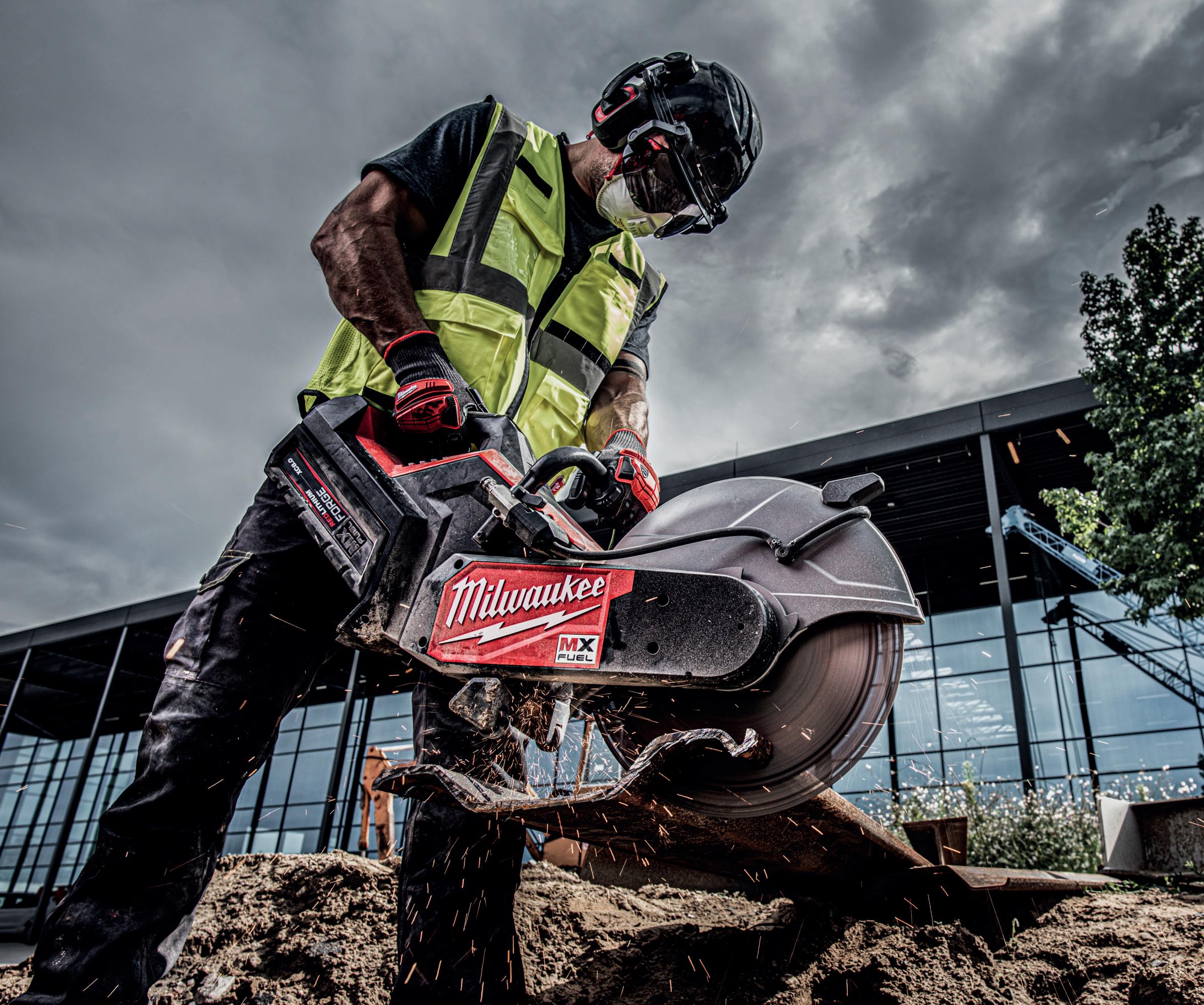
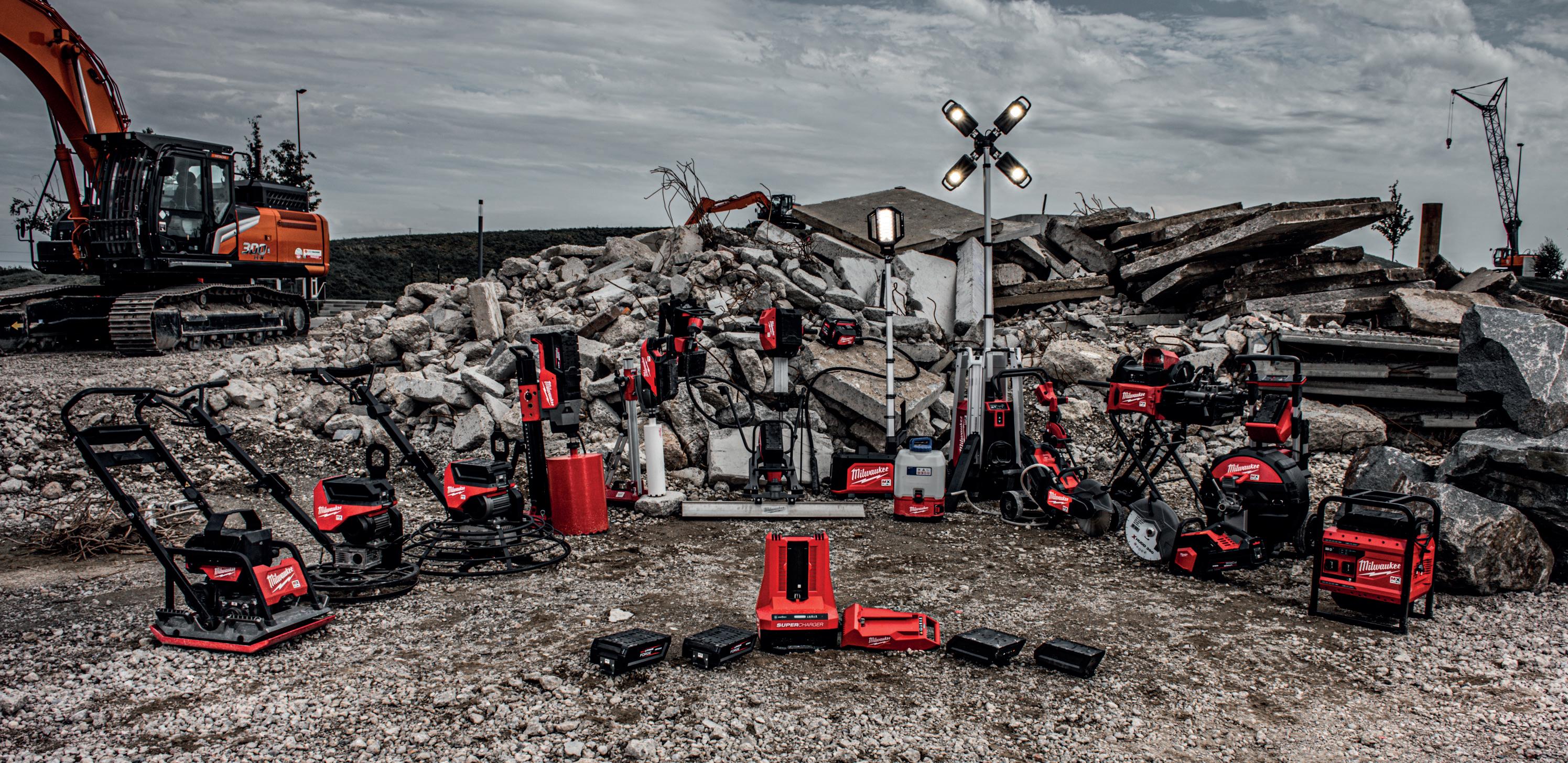
The continued reliance on petrol-powered equipment poses significant risks, not only to workers but also to the environment, as harmful emissions such as benzene and carbon monoxide degrade air quality and contribute to a range of health problems.
As the demand for healthier and more sustainable practices increases, the industry now finds itself at a crossroads: it’s time to make the shift to cleaner, more efficient tools. Kim Ehrler, MILWAUKEE® Product Manager, Power Tools EMEA, tells us more.
The hidden costs of petrol-powered tools
The dangers of prolonged exposure to petrol fumes are welldocumented. These emissions are linked to a variety of serious health conditions, including heart disease, lung cancer, respiratory issues, and even neurological disorders. Fine particulate matter (PM) emitted from petrol-powered equipment is a particular concern, as it can lead to the development of chronic conditions like emphysema and asthma. These health problems not only affect workers on construction sites, but also the general public, particularly in urban areas where construction activity is concentrated.
A recent study by the UK Health Forum and Imperial College London highlighted just how significant the impact of reducing fine particulate pollution could be. The research found that a reduction of just 1 μg/m³ in air pollution could prevent tens of thousands of health issues, including coronary heart disease, strokes, asthma, and lung cancer over an 18-year period.
Additionally, data from the European Environment Agency reveals that nearly 97% of Europe’s urban population is exposed to fine particulate matter levels that exceed the health-based guidelines set by the World Health Organisation (WHO).
These alarming statistics reinforce the importance of shifting away from petrol-powered tools. The move to cleaner alternatives is not only beneficial for workers’ health but also for improving air quality in urban areas, which will have far-reaching benefits for public health.
A growing awareness and shift towards sustainability
The global awareness of environmental and health issues has sparked significant changes in many industries, and the construction sector is no exception. Sweden and Denmark are leading the charge in tackling the issue of petrol emissions. Sweden’s ‘Fossil Free Sweden’ initiative is one example of how governments are pushing for stricter emission standards on equipment, making it more difficult for older, less-efficient petrol-powered models to remain in use.
Similarly, Denmark’s ‘Green Public Procurement’ program prioritises the purchase of environmentally-friendly construction equipment and machinery by public institutions, encouraging a shift towards sustainable practices.
While governmental policy changes are important, one of the biggest catalysts for change has been the rapid advancements in battery technology. In the past decade, battery-powered tools have evolved significantly, offering the power and performance necessary to meet or even exceed the capabilities of their petrolpowered counterparts. With improvements in battery capacity, efficiency, and run-time, these tools have become a safer, cleaner, and more viable option for construction professionals.
The global awareness of environmental and health issues has sparked significant changes in many industries, and the construction sector is no exception

The benefits of battery-powered tools go far beyond environmental considerations. On busy construction sites, the elimination of long extension cords provides greater mobility, flexibility, and convenience. With no need to worry about tangled cables or tripping hazards, workers can move more freely and focus on the task at hand. Additionally, cordless tools reduce the time spent managing cords, which leads to improved site organisation and efficiency.
Battery-powered tools also have significant safety advantages. Workers are less likely to trip over, cut through, or become entangled in cables, which can be particularly dangerous when working at heights or in tight spaces. Moreover, many batterypowered tools feature rapid shut-off capabilities, which immediately power down the tool in emergency situations, preventing further injuries. In contrast, petrol-powered tools require manual intervention to switch them off, which can be dangerous if left running and presents an additional risk to those working nearby.
Despite these clear advantages, some misconceptions around battery technology persist, particularly around performance and run-time. These misconceptions have delayed the widespread adoption of battery-powered tools in construction. However, as more construction companies embrace the benefits of battery-powered equipment, the industry is beginning to see a significant shift.
Battery-powered tools are becoming increasingly popular and are now seen as a worthwhile investment. A recent survey of over 3,000 European construction workers, conducted by MILWAUKEE®, revealed that nearly all respondents felt safer using battery-powered tools compared to their petrol-powered counterparts. This shift in perception is largely due to the impressive advancements in battery technology, which now allow tools to perform at levels comparable to, or even exceeding, the capabilities of petrol-powered equipment.
MILWAUKEE®’s REDLITHIUM™ FORGE™ batteries, designed for the M18™ and MX FUEL™ systems, are a prime example of this leap in performance. These batteries offer increased capacity, longer run times, and more power, enabling tools to handle even the most demanding tasks that were once only achievable with petrol-powered tools.
The increase in power and torque ensures that users can complete jobs more efficiently, with fewer interruptions for refuelling or battery charging.
The transition to battery-powered tools is already underway, and the benefits are becoming increasingly evident. Not only do these tools offer improved safety, enhanced productivity, and reduced noise, but they also provide a sustainable solution for the industry. The environmental benefits—such as reduced emissions, improved air quality, and a smaller carbon footprint—make the switch to battery-powered equipment a priority for businesses committed to sustainability.
As battery technology continues to advance, costs will decrease, making these tools accessible to businesses of all sizes. The range of battery-powered equipment is also expanding, enabling the industry to tackle a boarder array of tasks with cordless efficiency.
The transition from petrol-powered tools to battery-powered equipment is no longer a matter of “if,” but “when.” For construction companies committed to sustainability, the benefits are clear: reduced emissions, healthier workers, and a smaller carbon footprint.
By embracing battery-powered tools, the construction industry can lead the charge toward a safer, cleaner, and more sustainable future. The time to act is now—because the future of construction is cordless.
Pestokill’s roots go back to 1985 when Dave Clements started out on his own as a ‘man in a van’. Four decades and an acquisition later and Pestokill is the UK’s largest independent pest controller

With qualified technicians local to every town and city in England, Scotland, Wales and Northern Ireland, Pestokill is a wellestablished business proud of the solid reputation they’ve built up over the years.
Dave Clements, Managing Director of Pestokill, took some time out recently to chat to FM Director about the company’s journey so far, the transition from traditional pest control methods to more digitally-led strategies, and what facilities managers should keep in mind when it comes to protecting their buildings from pests.
“I founded the company by myself back in 1985,” began Dave. “It grew steadily and by 2020 we had 260 staff spread across the UK. Then the COVID-19 pandemic hit and brought with it lots of changes within the industry.
Like many companies, we were concerned about the impact those changes would have on the future of the business. After significant discussion, it was eventually decided that it made good sense to be acquired by ANTICIMEX, a Swedish pest control company with a rich history dating back to 1934.”
Since the acquisition, Pestokill has evolved in its pest control practices, now using digital technology to provide a more preventative approach.
“We are a commercial pest controller dealing with preventive measures,” explained Dave. “Traditionally, pest control was basically tempting the pests in, letting them breed for a few weeks until we knew they were there and then killing them with poison.
“That’s now changed. Today we use digital devices to monitor buildings 24/7 and to spot any pest entry.

“We know within five minutes if a mouse or a rat has entered anywhere in the building and we’re able to deal with that one –without poison - before it’s had chance to breed and multiply.”
Speed is of the essence in pest control with one pair of rats producing up to 1,000 babies in just one year. In addition, one mouse can produce between 60 and 80 droppings in one day, and so from a hygiene perspective, it’s vital to catch them as soon as possible. Thanks to these new technology-driven methods, pest controllers are now able to help facilities managers do just that.
As with any industry, the pest control sector is not without its own unique challenges. So, what challenges are keeping Dave and the team on their toes at the moment? “We are at constant threat from pests,” Dave said. “There are more and more invasive species being found in different countries.
“There are different flies and insects that are arriving in countries where they’ve never appeared before. This means that we’re now not only dealing with traditional pests, but we’ve now also got invasive species from around the world to content with.
“Take the Asian Hornet for example. It’s a huge wasp that attacks other wasps and bees usually found in mainland Europe that’s now invading parts of the UK. We now have to factor them into our pest control strategies and be as prepared as possible. There’s always another pest looking to take advantage of humans and our inability to protect ourselves.
“Apart from that, probably the biggest challenge we have right now is educating our clients; getting them to trust that the conventional methods that have been used for the last 30 years aren’t working, and that they can be done better with technology,” Dave said.
We are a commercial pest controller dealing with preventive measures

“It can be tricky getting the clients, accept and adopt digital systems when they’ve always been used to it being done one way.
“But it’s backed up by logic and we are steadily winning clients over on what we’re doing because not only are we solving problems we couldn’t solve in the past, but we’re also getting to the root of the problem - finding pests earlier before they can become a real problem.”
What can facilities managers do?
So, what can facilities managers do to help in the fight against pests? It’s fairly simple according to Dave. “Facilities managers need to be aware of what pests can use to their advantage and then guard against it.
“They should regularly walk around their building to check out any holes, gaps or voids that could potentially provide an entrance to a pest. Keep in mind that a mouse only needs a hole as wide as a pen to get in!
“They should also remember that food scraps and waste are pure temptation for mice and rats and should remind all occupiers of their building to put any food away securely to avoid pests turning up for a feed.
“We’ve got to be smarter than the pests. We have to try to prevent them in the first place or detect them as early as possible.”
For more information, please visit new.pestokill.co.uk
Facilities managers need to be aware of what pests can use to their advantage and then guard against it
Access transformation and its impact on FM service delivery

Both hard and soft FM service delivery relies on staff and subcontractors having access to the premises.
While it is not an issue during the working day, after-hours access can become a costly logistical challenge, especially with a large number of locations to manage.

For years, traditional keyholding was the answer; keys had to be collected from a central location or a member of staff had to travel to site to let contractors in.
However, this approach is far from efficient. Aside from the time and fuel wasted simply collecting and returning keys (consider the CO 2 emissions produced in the process), keys are frequently misplaced, lost, or simply not returned, resulting in expensive key and lock replacement charges and, for an FM company, an awkward conversation with the client to explain the situation.
This age-old method can also result in unnecessary missed visit charges when contractors arrive on site but are unable to gain access to deliver their services.
There is an abundance of digital access control solutions on the market that incorporate the latest technology, biometrics and mobile credentials.
However, most of these are only suitable for business-hours, and after-hours or weekend access when the building is hard-locked remains problematic. Furthermore, such systems are very expensive, requiring a substantial investment in building access-point and power supply adaptation.
While entirely digital access control will most certainly become mainstream in the future when energy storage solutions improve and scale cost reductions can be offered, the truth is that this will be many years hence.
For this reason, it’s not surprising that digital key safes are becoming increasingly popular in the FM sector.
They act as a bridge between the old keyholding methods and fully digital solutions, requiring low investment while providing full access traceability.
SentriGuard®, a key management solution by Keynetics, for example, integrates commercial grade security with the latest digital access control features; there is an app for key safe access and a platform for remote access management and auditing.
Due diligence must be applied when implementing any new security solution, particularly access control, whether mechanical or fully digital.
Both FM and security teams must ensure that the system meets both physical and digital security requirements; otherwise, the innovation will create a serious risk to the business.
This is where product certification can help to determine the quality of the chosen solution. In this regard, Keynetics’ SentriGuard key safes are certified to C1 and C3 grades of LPS 1175 (a loss prevention standard by LPCB) and have undergone numerous attack tests at the BRE facilities.
There is a common acceptance that, keyholding methods need to change to improve the responsiveness for effective FM service delivery, but due diligence must be a prime consideration in the decision-making process when selecting a new access control system.
Due diligence must be applied when implementing any new security solution, particularly access control, whether mechanical or fully digital
FM is evolving... so are we! As part of our new look, Business Daily will provide smarter, more targeted news and insights three times per week, on Mondays, Wednesdays and Fridays.
Three per week
• Monday: hard services and construction focus
• Wednesday: soft services focus
• Friday: a combo of the week’s biggest stories, video interviews and exclusive features from across the FM industry
As our name – FM Business Daily – suggests, we’re still updating our website every single day with all the latest stories and updates from all the FM sectors. Check it out to stay in the loop!
We hope you are as excited as we are about the new look FMBD newsletter, and we’d love you to get in touch if there’s anything you’d like to discuss or feature in an upcoming issue.
Subscribe here

